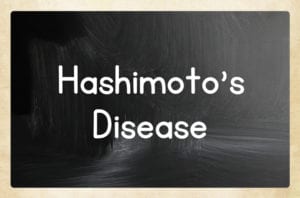Written by Taylor Woosley, Staff Writer. 12-month supplementation of a combination of 83 µg Selenium in the form of L-Se-meth and 600 mg Myo-Inositol significantly reduced TSH levels by 38%.
 Hashimoto thyroiditis (HT) is one of the most common autoimmune disorders that develops because of genetic susceptibility, X chromosome inactivation patterns modulated by environmental factors, along with microbiome composition1. HT is characterized by chronic inflammation, with tertiary lymphoid follicles development, and increased concentrations of circulating autoantibodies against thyroid peroxidase (anti-TPO) and thyroglobulin (anti-Tg)2. HT symptoms include chronic fatigue, nervousness, mood swings, and gastrointestinal or cardiovascular problems3.
Hashimoto thyroiditis (HT) is one of the most common autoimmune disorders that develops because of genetic susceptibility, X chromosome inactivation patterns modulated by environmental factors, along with microbiome composition1. HT is characterized by chronic inflammation, with tertiary lymphoid follicles development, and increased concentrations of circulating autoantibodies against thyroid peroxidase (anti-TPO) and thyroglobulin (anti-Tg)2. HT symptoms include chronic fatigue, nervousness, mood swings, and gastrointestinal or cardiovascular problems3.
A vast variety of nutrients play an important role in the onset and development of HT, including high iodine intake, inadequate protein intake, and deficiencies of selenium (Se)4. Se is an essential micronutrient, with the thyroid gland having the highest Se content per gram of tissue, because it expresses specific selenoproteins, such as glutathione peroxidase and iodothyronine deiodinases, which play an important role in thyroid function5. Additionally, myo-inositol is a carbocyclic polyol that regulates the generation of hydrogen peroxide in thryocytes, which is crucial for thyroid hormone biosynthesis6.
Pace et al. conducted an observational and retrospective study to assess the effect of a combination of selenomethionine (Se-meth) and myo-inositol (Myo-I) supplementation on HT disease evolution. Data used was from patients examined in an outpatient thyroid clinic with available medical records and an inclusion criteria consisting of treatment with either oral Se-meth (83 µg Se in the form of L-Se-meth) or combined Se-meth plus Myo-I (83 µg Se in the form of L-Se-meth and 600 mg Myo-I) for at least 12 months. Furthermore, subject inclusion consisted of TSH levels between 2.5 and 10 mIU/L, with normal free thyroxine (fT4) and free triiodothyronine (fT3) level, with positive serum TgAb and/or TPOAb, with ultrasound imaging with a pattern of chronic thyroiditis without the typical feature of nodular goiter. All included patients had data on serum TSH, fT3 and fT4 concentrations before treatment and at 6 and 12 months of treatment.
Primary study outcomes were comparing the thyroid hormonal trend (TSH, fT4 and fT3) in the three patient groups. Secondary study outcomes were evaluation of the variations in thyroid echogenicity before and after treatment. High-resolution ultrasounds to assess tissue density were performed at baseline, 6 months, and 12 months by two expert thyroid ultrasonography operators. 101 patients with available medical records were included in the final analysis (86 women and 15 men, mean age 45.4 ± 14.2 years). A control group of untreated patients with the same inclusion criteria were also included in the analysis. Of the 101 patients, 29 were untreated, 29 received Se-meth, and 43 subjects received an oral combination of Se-meth plus Myo-I.
Analysis of repeated measurements of TSH values over time were assessed by multilevel linear regression analysis to compare changes between untreated patients and patients in both the Se-meth group and the Se-meth and Myo-I groups. Among the patients, 60 (59.4%) were experiencing subclinical hypothyroidism: 10/29 (34.5%) in the control group, 15/29 (51.7%) in the Se-meth group and 35/43 (81.4%) in the Se-meth plus Myo-I group. Significant findings of the study are as follows:
- At 6 months, only the Se-meth plus Myo-I group experienced a significant reduction in TSH (p = 0.007).
- After 12 months, the untreated patients had significantly increased TSH levels (p = 0.02). Both treated groups experienced a significant reduction in TSH. This reduction was more pronounced in the Se-meth plus Myo-I compared to the Se-meth group (38% vs. 31%, respectively).
- The Se-meth plus Myo-I group experienced an initial reduction of the percentage of subclinical hypothyroidism of 81.4% at baseline to 67.4% at 6 months (p = 0.14). However, there was an increase to the stable value of 79.1% at 12 months (p = 0.79).
Results of the observational retrospective study show that, while both Se-meth groups had an improvement in TSH levels, the combination of Se-meth plus Myo-I experienced the most significant improvement in TSH. Further research on the thyroid protective benefits of selenium and myo-inositol supplementation is necessary.
Source: Pace, Cinzia, Dario Tumino, Marco Russo, Rosario Le Moli, Adriano Naselli, Graziella Borzì, Pasqualino Malandrino, and Francesco Frasca. “Role of selenium and myo-inositol supplementation on autoimmune thyroiditis progression.” Endocrine Journal 67, no. 11 (2020): 1093-1098.
©The Japan Endocrine Society
Click here to read the full text study.
Posted January 31, 2024.
Taylor Woosley studied biology at Purdue University before becoming a 2016 graduate of Columbia College Chicago with a major in Writing. She currently resides in Glen Ellyn, IL.
References:
- Klubo-Gwiezdzinska J, Wartofsky L. Hashimoto thyroiditis: an evidence-based guide to etiology, diagnosis and treatment. Pol Arch Intern Med. Mar 30 2022;132(3)doi:10.20452/pamw.16222
- Cayres LCF, de Salis LVV, Rodrigues GSP, et al. Detection of Alterations in the Gut Microbiota and Intestinal Permeability in Patients With Hashimoto Thyroiditis. Frontiers in immunology. 2021;12:579140. doi:10.3389/fimmu.2021.579140
- Osowiecka K, Myszkowska-Ryciak J. The Influence of Nutritional Intervention in the Treatment of Hashimoto’s Thyroiditis-A Systematic Review. Nutrients. Feb 20 2023;15(4)doi:10.3390/nu15041041
- Danailova Y, Velikova T, Nikolaev G, et al. Nutritional Management of Thyroiditis of Hashimoto. Int J Mol Sci. May 5 2022;23(9)doi:10.3390/ijms23095144
- Mikulska AA, Karaźniewicz-Łada M, Filipowicz D, Ruchała M, Główka FK. Metabolic Characteristics of Hashimoto’s Thyroiditis Patients and the Role of Microelements and Diet in the Disease Management-An Overview. Int J Mol Sci. Jun 13 2022;23(12)doi:10.3390/ijms23126580
- Barbaro D, Orrù B, Unfer V. Iodine and Myo-Inositol: A Novel Promising Combination for Iodine Deficiency. Front Endocrinol (Lausanne). 2019;10:457. doi:10.3389/fendo.2019.00457
